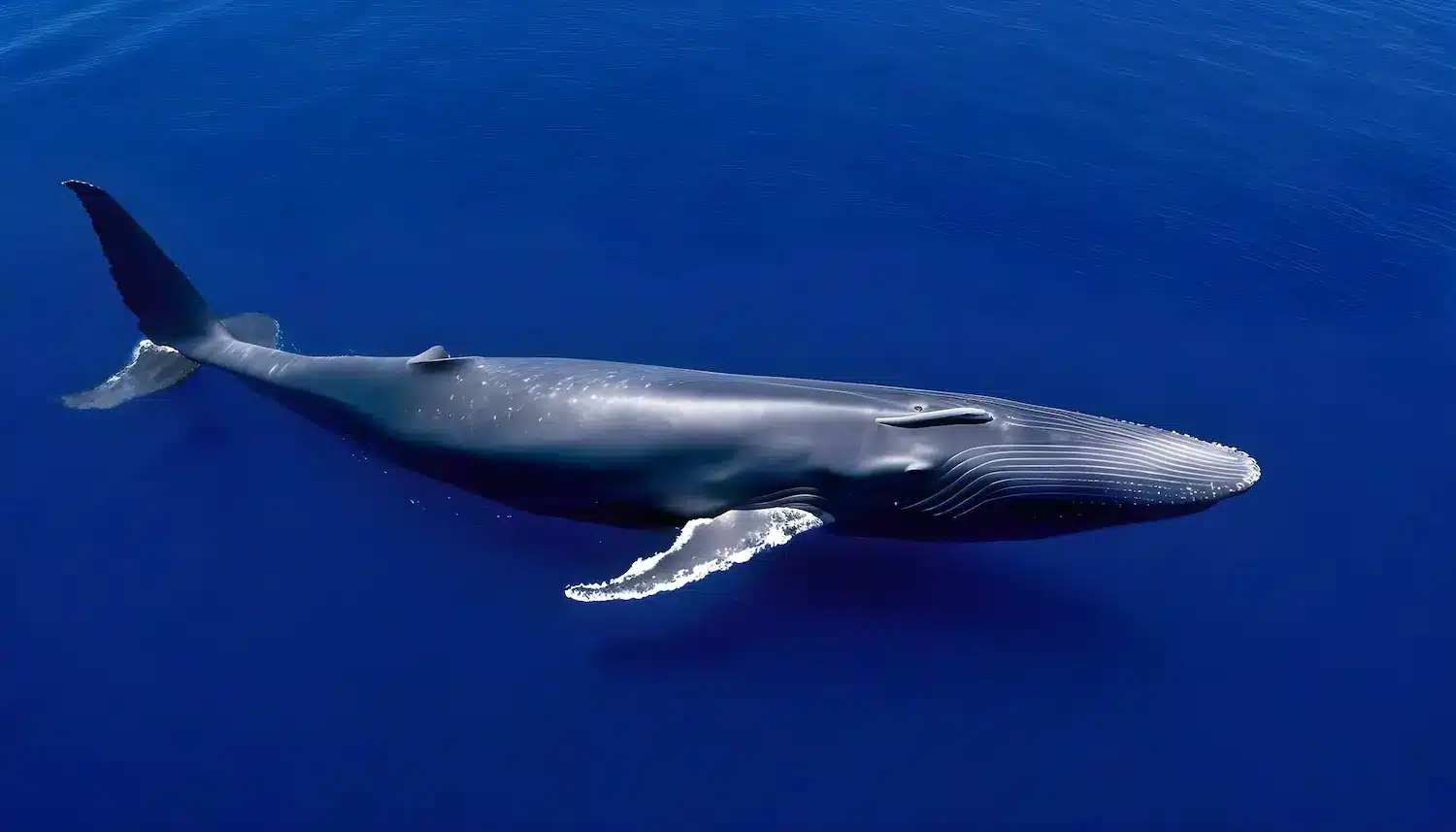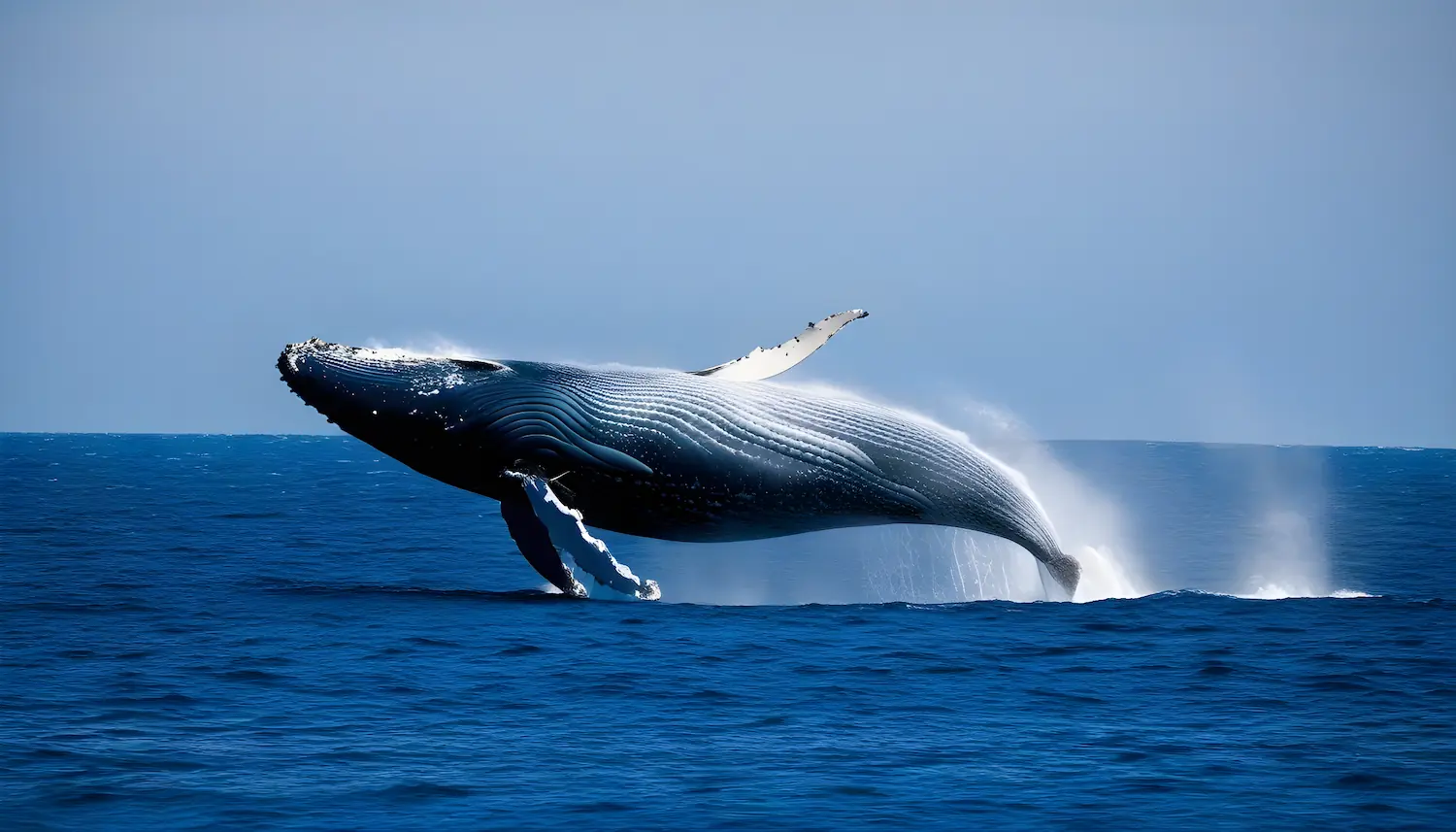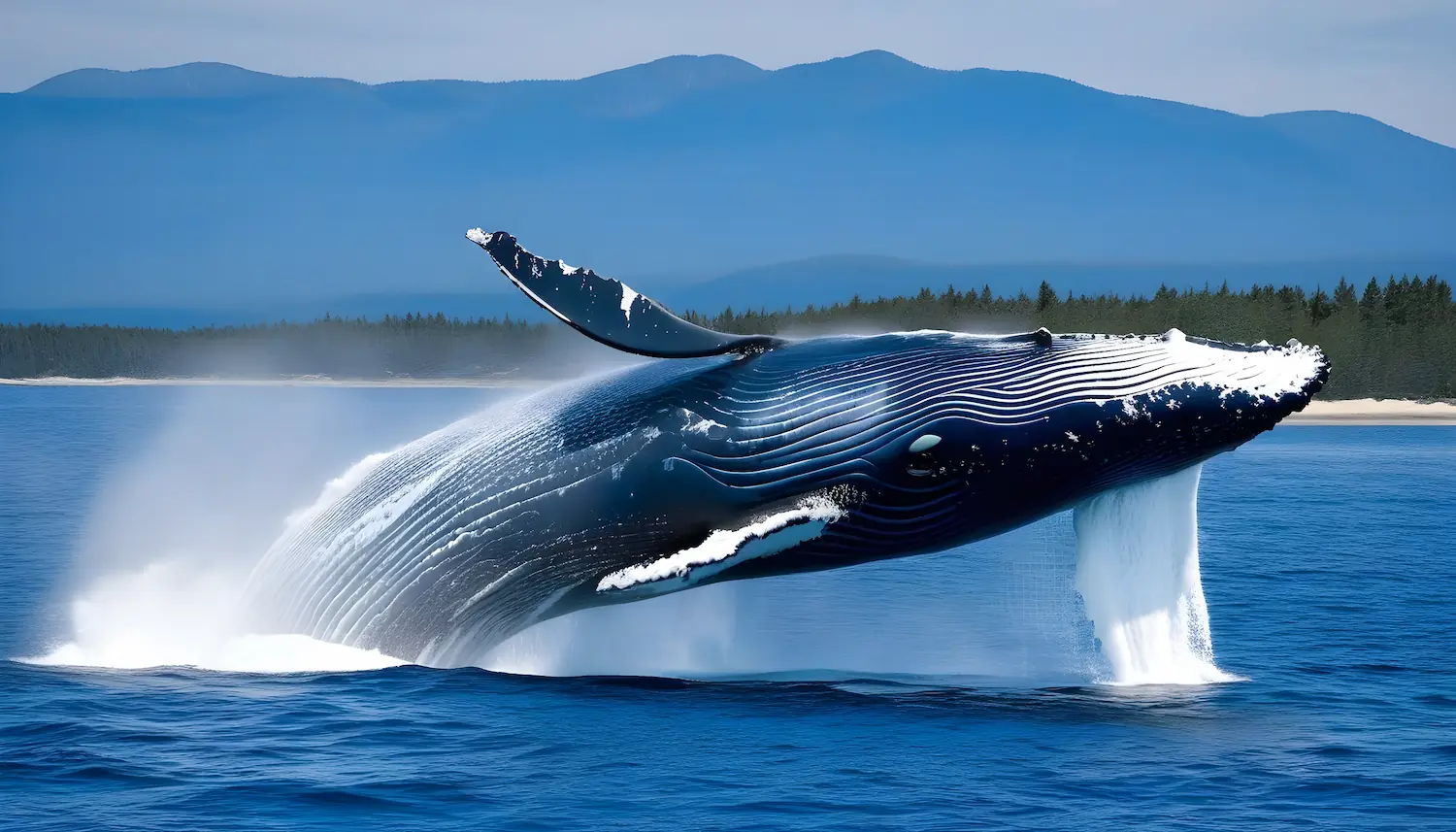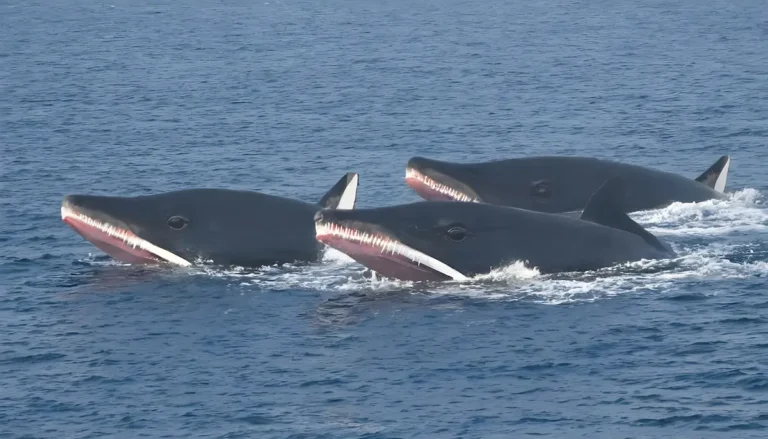All About the Blue Whale (Balaenoptera musculus)
- 🐋 Largest Animal: The blue whale holds the title of the largest animal on Earth.
- 📏 Size Measurements: It can reach a length of 100 feet (30.5 m) and weigh up to 200 tons, equivalent to the weight of 30 elephants.
- 🛫 Comparative Length: The blue whale’s length surpasses even the longest jumbo jet.
- 👅 Impressive Tongue: The blue whale possesses a remarkable tongue that weighs two tons.
- ❤️ Enormous Heart: Its heart is as large as a small car, adding to the astounding features of the blue whale’s anatomy.
Breathing
- 🌊 Ocean Survival Adaptations: The blue whale has multiple adaptations facilitating survival in the ocean.
- 🌬️ Blowhole Functionality: Its blowholes are a key adaptation, enabling the whale to breathe with only the top of its head above water.
- 🐋 Blowhole Characteristics: Similar to all baleen whales, the blue whale possesses two blowholes, positioned side-by-side on the top of its head.
- 🚿 Diving Mechanism: Before returning underwater, a flap covers and seals the blowholes to prevent water from entering, showcasing an essential mechanism for diving.

Size
Largest Mammal: The blue whale holds the title of the largest mammal on Earth, boasting an average length of 88 feet (27 m).
Range
- Global Distribution: Blue whales are found worldwide, inhabiting various oceans.
- Population Estimate: Scientists estimate the global blue whale population to be around 15,000.
Eating
- Dietary Adaptation: The blue whale lacks traditional eating utensils but utilizes baleen—a set of 300 to 400 fringed plates, each up to 3 feet (1 m) long, hanging from its upper jaw.
- Feeding Mechanism: To consume its diet of water and krill, the blue whale gulps a mouthful, closes its mouth, uses its tongue to expel water, and then swallows the retained krill.
- Baleen Functionality: The baleen acts like a spaghetti strainer, letting water exit while trapping krill for consumption.
Millions of krill
- 🦐 Dietary Preference: Blue whales predominantly feed on krill, tiny shrimplike invertebrates.
- 🍽️ Daily Consumption: They consume an impressive 7,900 pounds (3,600 kg) of krill daily, equivalent to about 40 million krill.
- 🌐 Feeding Requirement: Due to their krill-centric diet, blue whales need larger and denser “prey patches” (concentrations of prey) compared to other baleen whales.
Eyes bigger than its esophagus
- Esophagus Size Limitation: The blue whale’s esophagus has a diameter of only four inches (10.1 cm), restricting the ability to swallow large prey.
- Krill Consumption Necessity: Due to the esophagus size, blue whales are reliant on a continuous supply of krill.
Reproduction
Finding a mate
- 🐋 Sexual Maturity: Blue whales attain sexual maturity at approximately six to ten years old.
- 🔄 Mating Frequency: After reaching maturity, they engage in mating every two years.
- 👥 Partner Dynamics: While pairs may stay together for multiple years, blue whales are not known to form lifelong partnerships, and mating partners may vary.
How many elephants is that?
- Pregnancy Duration: After an 11-month pregnancy, female blue whales give birth in winter, typically in tropical or subtropical waters.
- Newborn Weight Comparison: The newborn calf weighs approximately 4,000 pounds, roughly half the size of an elephant.
- Maternal Nursing Period: During the first six months of life, the baby blue whale, known as a calf, nurses on its mother’s fatty milk.
- Nursing Intake: While nursing, the blue whale calf consumes a remarkable 100 gallons of milk daily.
- Growth Rate: It can gain nine pounds (4.1 kg) per hour and grow up to 1.5 inches (3.8 cm) each day.
- Seven-Month Milestone: By seven months, the calf reaches a length of 50 feet, equivalent to a Mack truck, and weighs 46,000 pounds, comparable to the weight of four elephants.
Predators
- 🦈 Predator: The only known natural predator of the blue whale is the orca (killer whale).
- 🌊 Limited Threats: In the ocean, aside from orcas, the blue whale faces minimal natural threats, earning its reputation as a gentle giant.
- 🌍 Human-Induced Dangers: The primary risks for blue whales come from dangers associated with human activities.
Population
- Global Population Estimate: Scientists estimate the current worldwide population of blue whales to be 15,000.
- Regional Distribution: Three main populations are identified in the northern Atlantic Ocean, North Pacific Ocean, and the Southern Hemisphere.
- California Summer Population: The population of blue whales summering off California is estimated at 2,000 animals, and it appears to be the only population potentially thriving.
- ☠️ Historical Mortality Rates: Due to high mortality rates from whale hunting, some blue whale populations faced such severe impacts that recovery may be challenging or even impossible.
Whale calls
- 🎶 Volume Record: The blue whale is one of the loudest animals on Earth, producing sustained sounds at 188 decibels.
- 🌊 Communication Range: Individuals can call out to each other from hundreds of miles away, creating a shout across the open ocean.

Habitat
The blue whale’s habitat extends from polar to tropical waters, with the species making extensive seasonal migrations, ranging from equatorial locations in winter to the Arctic or Antarctica in the summer.
Between ice and a cold place
Blue whales, known to swim near icebreakers and islands, faced a tragic incident in 2014 when nine individuals died after getting stuck in ice patches off the Canadian coast.
In Monterey Bay
During summer, blue whales, with a global population estimate of 15,000, migrate to Monterey, a prime feeding ground where 2,000 whales, among the world’s largest concentration, indulge in their preferred diet of krill.
Monterey is a prime destination for summer whale watching, offering enchanting views of blue whales near the canyon that crosses Monterey Bay.
Tips for spotting a blue whale.
- 💦 Distinctive Spouting: Blue whales are recognized by a high, vertical eruption of water resembling an exploding fire hydrant.
- 🎨 Color and Pattern: Their enormous size aside, blue whales have a blue-gray color with mottled blue, white, and gray spots.
- 🐾 Dorsal Fin Feature: A tiny, stubby dorsal fin, located three-quarters of the way down its back, is a notable characteristic of the blue whale.
Whale-less winter
Blue whales migrate to warmer waters in winter for birthing and mating, surviving on body fat reserves due to the scarcity of krill until they can resume feeding.
Conservation
Decimated by whaling
- 🎯 Whaling Era Impact: The invention of the harpoon gun marked the beginning of intense whaling on blue whales.
- 📉 Population Decline: The pre-whaling population of blue whales plummeted from an estimated 350,000 to 1,000 in the mid-1920s.
- 🌍 Protection Measures: In 1966, the International Whaling Commission belatedly declared blue whales a protected species worldwide.
- 🚫 Legal Safeguards: The Endangered Species Act also provides protection for the blue whale.
Is the blue whale endangered?
- 🚨 Endangered Status: Yes the blue whale holds an endangered classification on the International Union for Conservation of Nature and Natural Resources (IUCN) red list.
- 🇺🇸 Endangered Species Act: Additionally, it is listed as endangered under the U.S. Endangered Species Act.
Threats
The IUCN identifies the fishing industry and climate change as major threats to blue whales, with climate change risking their primary food sources due to reduced productivity and the impact of ocean acidification on krill development.
Blue whales confront a serious threat from plastic pollution, with recent studies indicating alarming daily ingestion rates, emphasizing the urgent need for increased conservation efforts to address this environmental menace.
Cool Facts
- 🐋 Unique Nickname: In Arctic or Antarctic waters, the blue whale is nicknamed “sulfur bottom” due to yellow diatoms sticking to its underbody.
- 🍼 Calf Weight Gain: Nursing blue whale calves can gain up to 200 pounds (90 kg) of body weight per day.
- 😴 Sleeping Behavior: Blue whales sleep while swimming, avoiding full unconsciousness to prevent drowning. They engage in light naps while slowly swimming along the water’s surface.



![Do Whales Have Swim Bladders? [Explained]](https://oceanfauna.net/wp-content/uploads/2024/02/whales-upscaled-1-1-768x439.webp)

